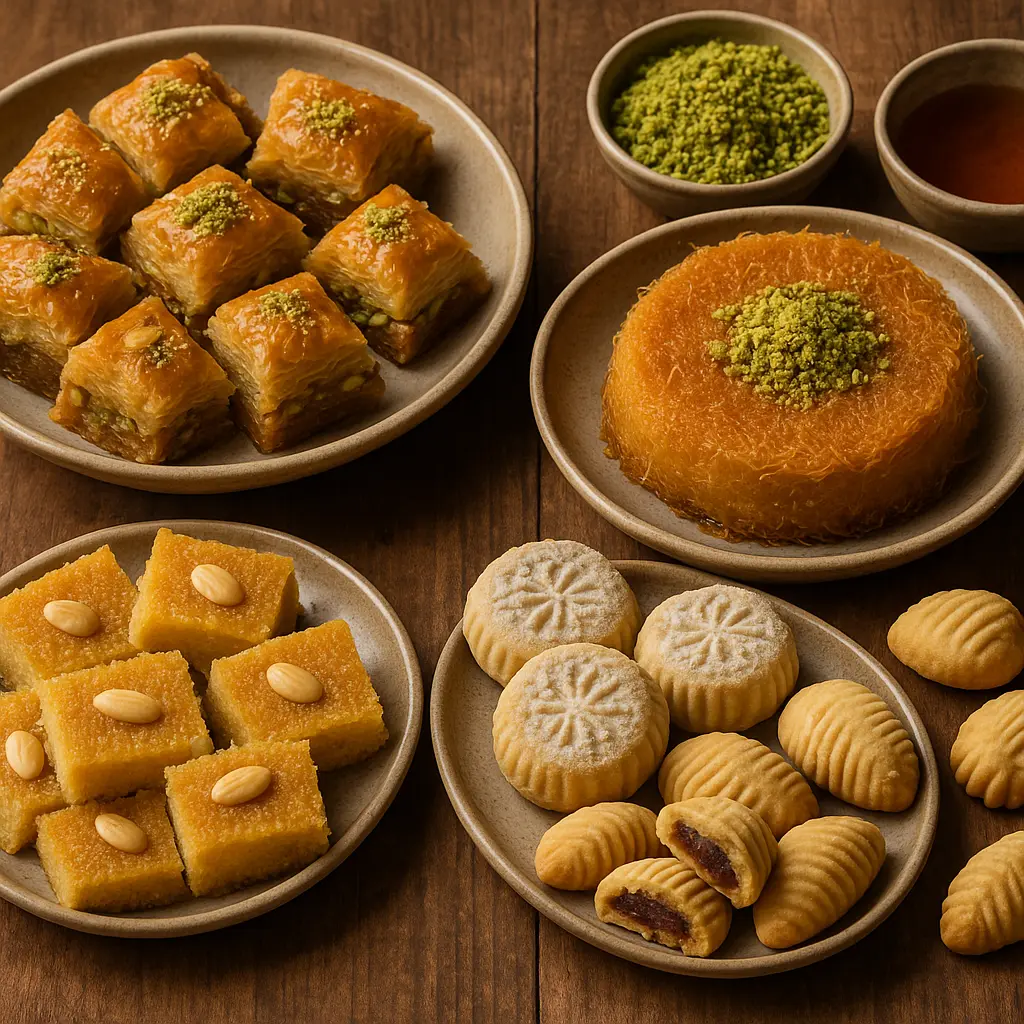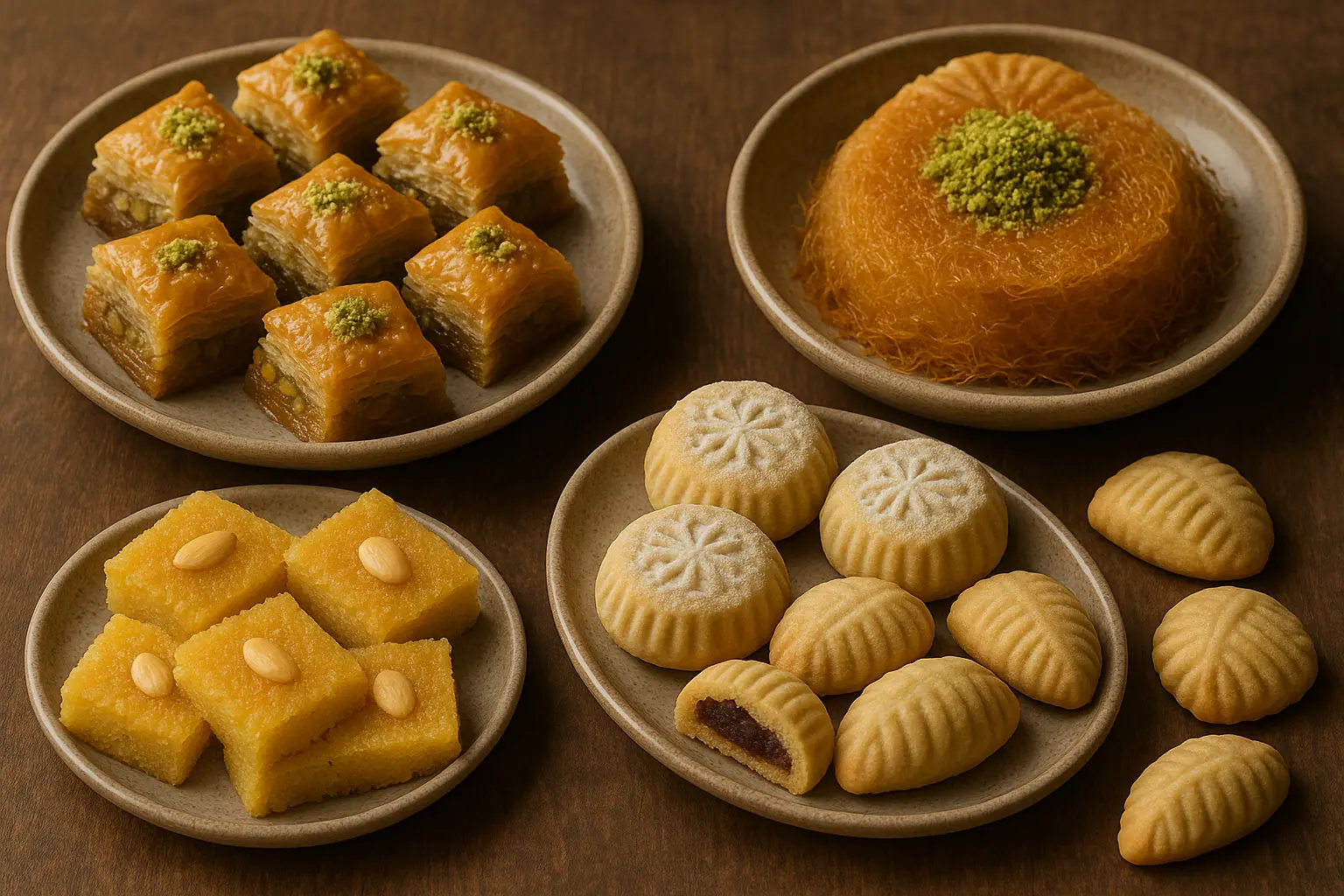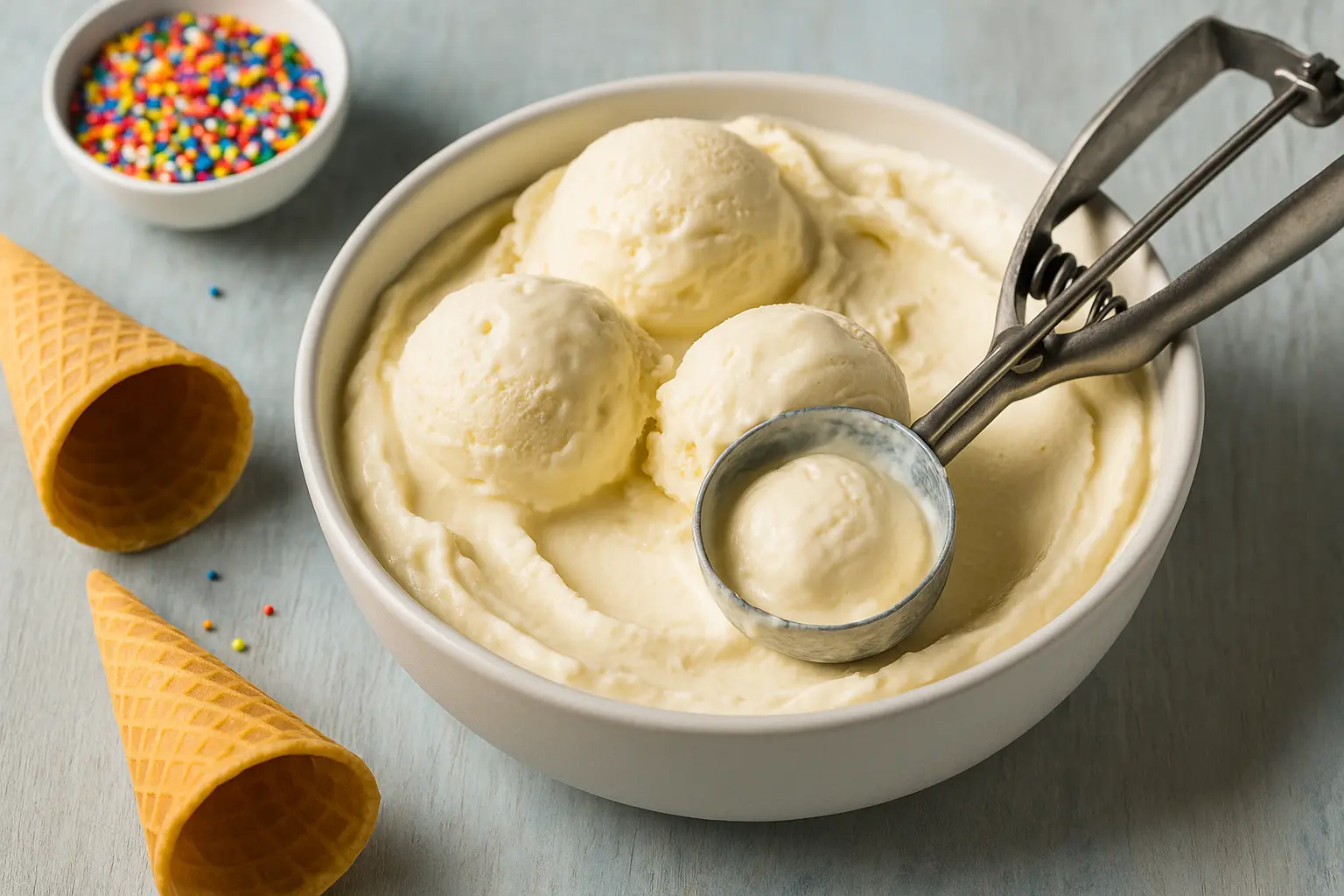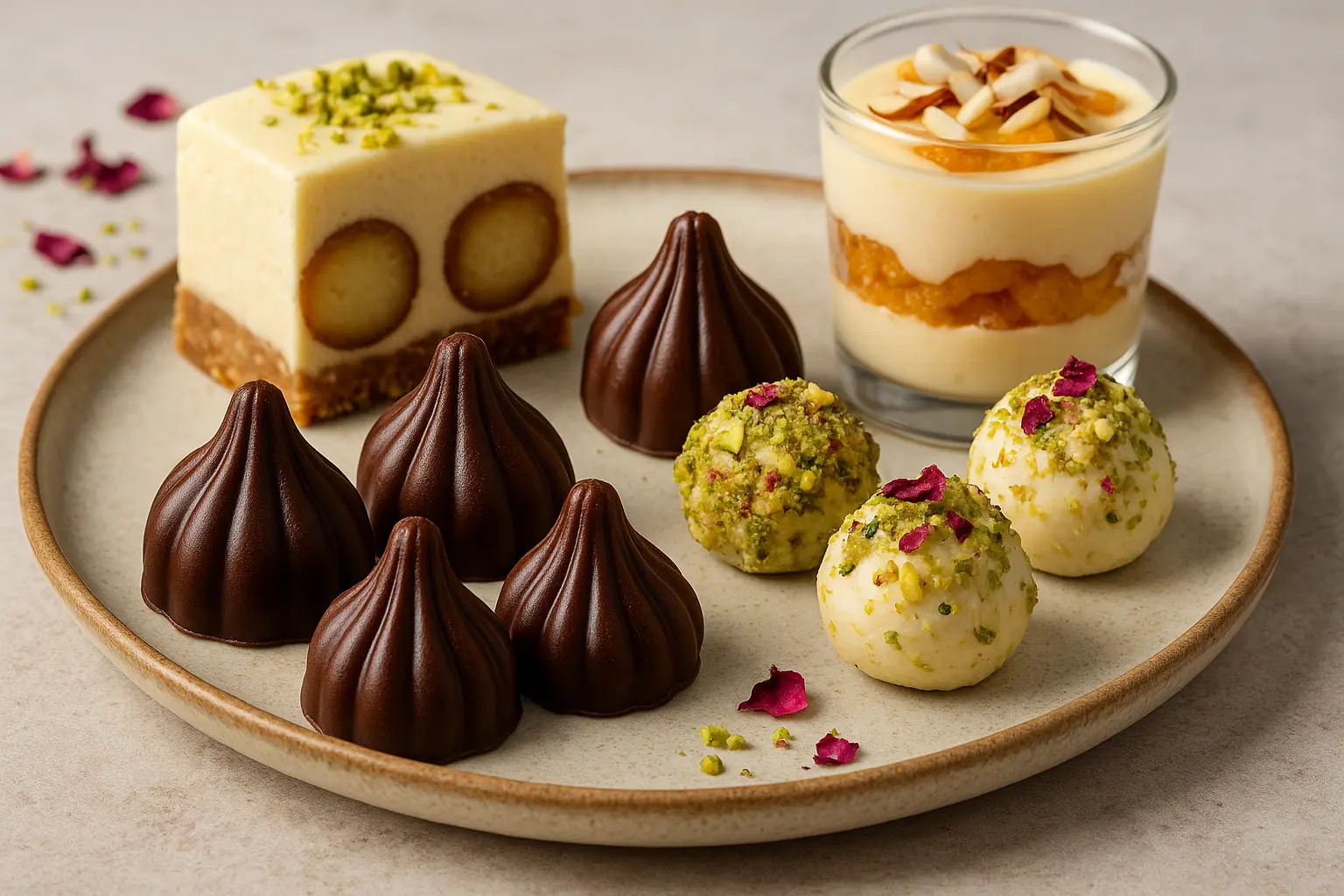The Middle East has a centuries-old love affair with sweets. Walk into any bustling souk during Ramadan, Eid, or weddings, and you’ll be greeted with trays of golden baklava, syrup-soaked semolina cakes, rosewater puddings, and pistachio-laden cookies. These desserts are more than food — they’re cultural symbols of generosity, hospitality, and joy.
What makes Middle Eastern sweets particularly festive is their rich use of ingredients — nuts, dates, honey, semolina, saffron, and aromatic rose or orange blossom water. They are indulgent but also deeply tied to tradition, making them a centerpiece for gatherings.

The Cultural Significance of Middle Eastern Sweets
Middle Eastern sweets are deeply woven into cultural rituals:
- Ramadan & Eid: After a month of fasting, families celebrate with trays of Maamoul (date-stuffed cookies) and qatayef (stuffed pancakes).
- Weddings & Engagements: Baklava, often studded with pistachios, symbolizes prosperity and shared sweetness.
- Religious Gatherings: Halva, a simple sesame sweet, is offered during mourning and celebrations alike.
- Everyday Hospitality: No visit is complete without a small sweet paired with strong Arabic coffee or mint tea.
Unlike Western desserts that lean on butter and cream, Middle Eastern sweets celebrate syrups, nuts, semolina, and natural sweeteners like dates and honey.
Essential Ingredients in Middle Eastern Desserts
If you’re new to this cuisine, stock these basics:
- Nuts: Pistachios, almonds, walnuts, cashews.
- Grains: Fine semolina, farina, couscous (occasionally).
- Sweeteners: Honey, sugar syrups infused with lemon, dates.
- Floral waters: Rosewater, orange blossom water.
- Dairy elements: Clarified butter (ghee), milk powder, cheese (for kunafa).
- Spices: Cardamom, cinnamon, nutmeg, saffron.
Quick Tip: If rosewater is unavailable, you can substitute with a tiny amount of vanilla extract + lemon zest.
Must-Try Festive Middle Eastern Sweets (with Recipes)
1. Baklava – The Crown Jewel
Baklava is perhaps the most iconic Middle Eastern dessert, with flaky filo pastry layers, buttery richness, and a nutty filling drenched in syrup.
Ingredients:
- 500 g filo pastry sheets
- 250 g unsalted butter, melted
- 2 cups mixed nuts (pistachios, almonds, walnuts), finely chopped
- ½ cup sugar
- 1 tsp cinnamon
- For syrup: 1 cup sugar, ½ cup water, 1 tbsp lemon juice, 1 tsp rosewater
Steps:
- Preheat oven to 180°C. Brush a baking tray with butter.
- Layer 10 sheets of filo, brushing each with butter.
- Spread nut mixture evenly.
- Add another 10 buttered sheets on top.
- Cut into diamond shapes. Bake 35–40 min until golden.
- Pour hot syrup over hot baklava. Let soak.
Shortcut: Buy pre-chopped nut mixes and ready-made filo pastry.
2. Basbousa (Semolina Cake)
A syrup-soaked semolina cake, often topped with almonds or coconut.
Ingredients:
- 2 cups semolina
- 1 cup yogurt
- 1 cup sugar
- ½ cup ghee or butter
- 1 tsp baking powder
- Garnish: whole almonds, desiccated coconut
Steps:
- Mix semolina, sugar, yogurt, and ghee into a thick batter.
- Spread into greased pan, score into squares, top with almonds.
- Bake at 180°C for 30–35 min.
- Pour cooled sugar syrup flavored with orange blossom water on top.
Festive Twist: Add shredded coconut or ground pistachios on top.
3. Maamoul (Date-Stuffed Cookies)
Buttery shortbread-style cookies filled with dates, nuts, or figs.
Ingredients:
- 3 cups semolina
- 1 cup ghee
- ½ cup milk
- 1 tsp yeast
- Filling: mashed dates with cinnamon and cardamom
Steps:
- Mix semolina, ghee, and yeast into a soft dough.
- Shape dough balls, stuff with date paste, press in wooden mold (optional).
- Bake 15–20 min until golden.
Festival Connection: Traditionally baked for Eid.
4. Kunafa (Cheese Pastry with Syrup)
Crispy shredded filo layered with sweet cheese and syrup.
Ingredients:
- 500 g kataifi (shredded filo dough)
- 250 g sweet cheese (or ricotta + mozzarella mix)
- 1 cup ghee
- Syrup: sugar, water, lemon juice, rosewater
Steps:
- Coat kataifi with melted ghee.
- Layer half in pan, add cheese, then top with rest.
- Bake until golden. Drizzle with syrup.
Shortcut: Use store-bought kataifi pastry and pre-shredded mozzarella.
5. Qatayef (Stuffed Pancakes)
Mini stuffed pancakes popular in Ramadan.
Fillings: Cream with nuts, or sweetened ricotta.
Steps:
- Cook small pancakes (only one side).
- Fill with cream or nuts.
- Fold and seal edges. Dip in syrup or serve fresh.
Simplifying Middle Eastern Sweets for Beginners
- Pre-made filo dough saves hours in baklava and kunafa.
- Date paste (sold in blocks) makes Maamoul easier.
- Flavored syrups can be made in batches and stored.
- Nut grinders save time versus chopping.
Serving & Pairing Ideas
- Pair sweets with Arabic coffee or mint tea.
- Serve mini assortments rather than large portions.
- Add fresh fruit (figs, pomegranates, oranges) for balance.
- Create a festive platter mixing cookies, cakes, and pastries.
Healthier Twists Without Losing Flavor
- Replace sugar syrup with honey or date syrup.
- Swap butter with light ghee or coconut oil.
- Use wholemeal semolina for added fiber.
- Reduce syrup quantity by brushing instead of soaking.
Beyond the Classics – Regional Variations
- Turkey: Pistachio-heavy baklava.
- Lebanon: Lighter semolina cakes with yogurt.
- Egypt: Basbousa with coconut and honey.
- Iran: Saffron halva with rosewater.
- Morocco: Chebakia (sesame honey cookies) served in Ramadan.
Conclusion: Sweet Celebrations, Simple Prep
Festive Middle Eastern sweets may seem elaborate, but with a few shortcuts and pantry staples, anyone can recreate them at home. These desserts not only satisfy the sweet tooth but also carry the warmth of tradition, community, and celebration.
Whether you’re preparing baklava for Eid, kunafa for a wedding, or basbousa just to brighten your week, these recipes will bring Middle Eastern charm into your kitchen.
So gather your nuts, floral waters, and semolina — and let the festivities begin!
Leave a comment
Your email address will not be published. Required fields are marked *




















